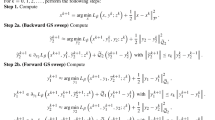Abstract
Compressive sensing can reconstruct compressible or sparse signal at the under-sampling rate. However small coefficients of the compressible signal with large number but low energy are hard to be reconstructed, while also infect the accuracy of the big coefficients. In this reason, for the compressive sensing algorithms such as orthogonal match pursuit (OMP) and tree-structed wavelet compressive sensing (TSW-CS), an assumed error is in the measurement model, which makes the reconstructed results not satisfy the original measurement model. Aiming at this problem, we propose the projection replacement (PR) algorithm by building the measurement space and its orthogonal complement space with singular value decomposition, and replacing the projection in measurement space of the reconstructed result with the pseudo-inverse one. The proposed PR algorithm eliminates the hypothetic measurement error in OMP and TSW-CS reconstructed model, and it guarantees theoretically that the PR results have a smaller error. Its effectiveness is verified experimentally with OMP and TSW-CS. The proposed algorithm serves as a good reconstruction algorithm for the CS-based applications such as image coding, super-resolution, video retrieval etc.




Similar content being viewed by others
References
Cands EJ (2006) Compressive sampling. In: Proceedings of the international congress of mathematics, vol 3, pp 1433–1452
Deng CW, Lin WS, Lee B-S, Lau CT (2012) Robust image coding based upon compressive sensing. IEEE Trans Multimed 14(2):278–290
Donoho D L (2006) Compressive sensing. IEEE Trans Inf Theory 52(4):1289–1360
Fannjiang A, Liao W (2012) Super-resolution by compressive sensing algorithms. In: IEEE Proceeding Asilomar conference on signals, systems and computers, pp 411–415
Golub GH, Loan CFV (2013) Matrix computation, 4th edn. John Hopkins University Press, Maryland
He L, Carin L (2009) Exploiting structure in wavelet-based Bayesian compressive sensing. IEEE Trans Signal Process 57(9):3488–3497
He L, Chen H, Carin L (2010) Tree-structed compressive sensing with variational Bayesian analysis. IEEE Signal Process Letters 17(3):233–236
Hou XS, Yang J, Jiang GF, Qian XM (2013) Complex SAR image compression based on directional lifting wavelet transform with high clustering capability. IEEE Trans Geosci Remote Sensing 51 (1):527–538
Ji S, Xue Y, Carin L (2008) Bayesian compressive sensing. IEEE Trans Signal Process 56(6):2346–2356
Kulkarin N, Nagesh P, Gowda R, Li BX (2011) Understanding compressive sensing and sparse representation-based super-resolution. IEEE Trans Circuits Syst Video Technol 22(5):778–789
Liu LW, Wang LH, Zhang M (2014) Depth map super-resolution based on joint dictionary learning. Multimed Tools Appl. doi:10.1007/s11042-014-2002-6
Mallat SG, Zhang Z (1993) Matching pursuits with time-frequency dictionaries. IEEE Trans Signal Process 41(3):3397–3415
Ruiz P, Babacan SD, Gao L, Li Z (2011) Video retrieval suing sparse Bayesian reconstruction. In: 2011 IEEE international conference on multimedia and expo, pp 1-6
Tropp JA, Gilbert AC (2007) Signal recover from random measurement via orthogonal matching pursuit. IEEE Trans Inf Theory 53(12):4655–4666
Wang LJ, Wu XL, Shi GM (2008) A compressive sensing approach of multiple descriptions for network multimedia communication. In: Processing IEEE workshop multimedia signal process, vol 1, pp 445–449
Xu L, Liang Q (2010) Compressive sensing using singular value decomposition. In: Lecture notes in computer science, vol 6221, pp 338–342
Acknowledgments
This work was supported by National Natural Science Foundation of China (No.61373113) and the Fundamental Research for the Central University (No.xjj2012023).
Author information
Authors and Affiliations
Corresponding author
Rights and permissions
About this article
Cite this article
Chen, Z., Hou, X., Gong, C. et al. Compressive sensing reconstruction for compressible signal based on projection replacement. Multimed Tools Appl 75, 2565–2578 (2016). https://doi.org/10.1007/s11042-015-2578-5
Received:
Revised:
Accepted:
Published:
Issue Date:
DOI: https://doi.org/10.1007/s11042-015-2578-5




